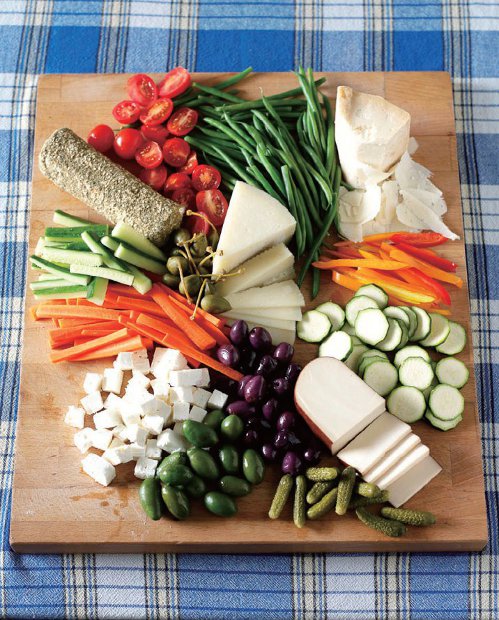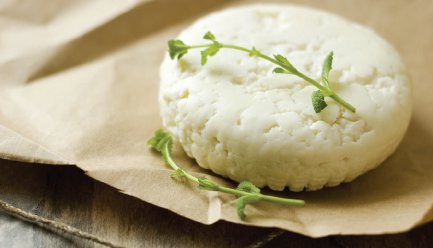
THE MARKET
SELECTING FRESH PRODUCE
Although it is sometimes tempting to eat fruits and vegetables that are out of season, when you do, you end up doing yourself and the planet a great injustice. Just as you rotate your wardrobe for the changing seasons, you should savor fruits and vegetables as they come into season. This is a great way to ensure that you get the freshest foods and also reduce your carbon footprint. Your food should not have to travel far to reach you. Honor your body by eating in harmony with nature.
When choosing fruit, it should be firm, unblemished, and dense for its size. For example, a ripe melon should feel weighty, not light and dehydrated or dry. Fruit shows when it is past its prime. It will turn brown and moldy, and its skin will appear withered and dry. When choosing citrus fruits, search out smooth, thin rinds since they tend to yield more juice.
Vegetables, especially leafy greens, should have a deep, vibrant color and hold their shape, not appear wilted, lackluster, or yellowed. Check that the stalks and roots are firm and intact and look healthy.
ORGANIC PRODUCE
At first glance, organic fruits and vegetables may not look different from non-organic produce, but they won’t appear shiny and waxed or perfectly symmetrical and spot-free. However, there is a difference between commercially appealing produce and produce that truly looks and smells fresh, ripe, and vibrant. Generally speaking, if it looks too good to be true, it probably is—meaning it will make a good centerpiece, but not good eating.
RARE OR HARD-TO-FIND PRODUCE
Exotic and rare fruits and vegetables are a pleasure when you are centering your diet on produce. Sweet potatoes and yams come in many different varieties that look and taste distinctly different; exchanging one for the other within a recipe can change the look and taste of the dish. If you are fortunate enough to have small ethnic communities where you live, seek out produce at the markets where the locals go. Korean, Indian, Southeast Asian, Spanish, Italian, and Japanese markets are great resources, abundant with detox-friendly produce and ingredients.
In a Spanish market, you might find jicama, plantains (or green bananas), yautias (a type of yam), chayotes, and yucca. You can also find many types of jalapeños and other peppers, tomatillos, and cilantro.
In Southeast Asian markets, look for kabocha squash, green papayas, purple yams, okra, Thai basil, assorted chile peppers, and exotic fruits such as mangoes, dragon fruit, durian, pomelos, and red bananas.
Korean and Japanese markets have a vast array of vegetables, such as mustard greens, red and green leaf lettuce, Japanese eggplants, daikon radishes, bamboo shoots, burdock root, lotus root, and sweet potatoes (satsumaimo).
SELECTING CHEESES
For detox diet purposes, always select goat or sheep cheese, especially raw and unpasteurized if available.
Fresh goat cheese, or chèvre, is a staple in my kitchen because of its versatility and can be used in salads, frittatas, and cream-based sauces. It makes a great substitute for sour cream by just adding lemon juice. You can make flavored cream cheeses by adding herbs and spices such as parsley, dill, scallions, garlic, or chipotle chile powder.
Raw sheep pecorino has the same nutty saltiness as Parmesan and is my favorite cheese. It is a good substitute for pasteurized cow Parmesan, and I use it as a finishing touch for many meals and salads.
Feta is a widely popular Mediterranean cheese, made from both goat and sheep milk, or a mix of the two. There are many varieties, such as Greek, Bulgarian, and French, each with its own level of saltiness and creaminess. Feta is the perfect addition to your green salad.
Halloumi is a hard cheese from Cyprus that stands up to grilling or baking. It makes great “croutons” for warm savory dinner salads.
To make a versatile cheese platter, use a soft cheese (like an herb-rolled chèvre log), a semisoft cheese (try a nutty, salty cheese like Midnight Moon, smoked sheep Gouda, or goat cheddar), and a hard cheese (raw sheep pecorino or aged Manchego). Instead of bread or crackers, serve crudité such as zucchini, carrot, and celery sticks, sliced cucumber, asparagus spears, and broccoli and cauliflower florets. Add an assortment of olives, cornichons, and caper berries with sliced tomatoes and onions, as well as a couple of spreads, such as Zucchini Hummus (see page 154) or Baba Ghanoush (see page 103), and this could easily turn into a decadent party platter.

SELECTING OLIVES
Olives should be dry-cured or cured in brine rather than in oil. They should be fresh and crisp, with pits. Watch out for olives stuffed with something you would rather avoid, such as almonds, blue cheese, or figs. Olives can be rinsed and strained under cold running water to remove excess salt, brine, and oils.
Cerignola are large, meaty olives and have a mild, subtle nutty flavor that is more neutral than other olives. They make a great base for a mixed olive plate.
Castelvetrano olives are fresh, small, crisp, and bright green. They make a perfect snack on their own but are also wonderful marinated with herbs and citrus, such as rosemary with orange zest.
Kalamata olives are typically available in oil or brine. Choose the brined variety and be sure to rinse them well. Chop them up in salads or tomato-based sauces, or puree them to make an olive tapenade or spread.